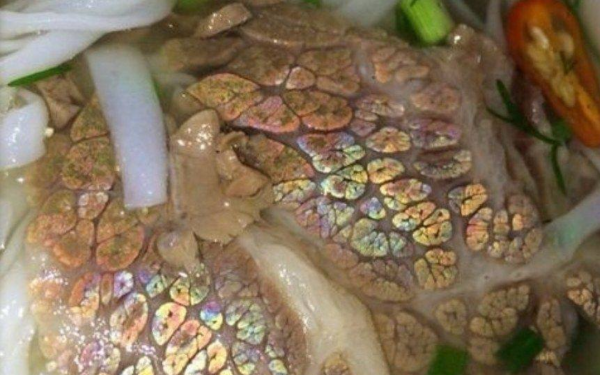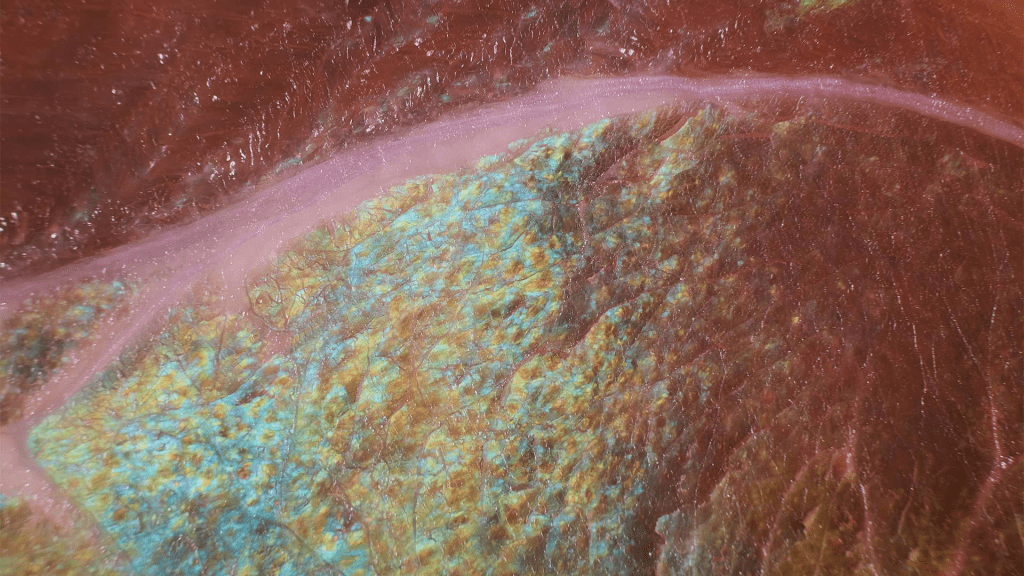If you’ve ever opened a pack of roast beef and found a shimmering rainbow on its surface, you might have wondered if the meat was safe to eat. That shiny, almost magical display can look strange, even a bit suspicious. But is it a sign of spoilage, or is there something more to it? Let’s dive into the science of iridescence in beef and other meats, and discover why your lunch meat sometimes looks like a prism!
What Causes the Rainbow on Beef? Understanding Structural Color

The iridescent effect you see on beef has little to do with the meat’s pigment and everything to do with structural color. Structural color occurs when the physical structure of a surface causes light to diffract, or split, into different colors. This is the same phenomenon that creates the colorful shine on things like butterfly wings, peacock feathers, and soap bubbles.
In the case of meat, the muscle fibers can sometimes align in such a way that they reflect light differently. As light hits these smooth muscle fibers, it bends and spreads out, creating a rainbow effect. The surface of the meat needs to be smooth for this to happen, which is why this shiny appearance is common in deli meats that have been thinly sliced by commercial-grade equipment.
Why Does Iridescence Appear Mostly on Deli Meats?
If you’ve noticed that this effect seems more common on store-bought cold cuts than on the meat you slice at home, you’re not alone. The shiny, rainbow effect often appears on deli meats such as roast beef, pastrami, and ham because of the equipment used to slice them.
Commercial meat slicers create extremely smooth cuts, which allow light to diffract off the meat’s surface in a uniform pattern. A smooth, even surface is essential for iridescence to occur. When you cut meat at home, the surface is usually a bit rougher, so light scatters in different directions, making the effect less noticeable.
Additionally, darker meats like beef and pastrami are more likely to show iridescence because the darker background provides a contrast, enhancing the rainbow colors. On lighter meats, the colors can be harder to see.
Iridescence vs. Spoilage: When Should You Be Concerned?
While the shiny rainbow effect is harmless, certain colors on meat can indicate spoilage. The USDA points out that iridescence alone does not mean that the meat is bad. However, a greenish tint could be cause for concern. Here’s how to tell the difference:
- Harmless Iridescence: If the rainbow effect has no accompanying smell or slimy texture, it’s likely due to light diffraction and is safe to eat.
- Green or Gray Colors: A green or gray hue can sometimes result from a benign change in pigment due to processing, but it can also indicate the presence of spoilage organisms like mold.
To be sure, always give the meat a quick sniff and feel. If it smells sour, feels sticky, or appears to have mold spots, it’s best to throw it away. And of course, always check the sell-by date before consuming meat.
How Does Light Diffraction Cause Iridescence on Meat?
The process of light diffraction sounds complicated, but it’s a simple concept. When light hits an object, it usually bounces back at the same angle. However, certain surfaces cause the light to split, or diffract, creating a spectrum of colors. This is why you see rainbows on objects like CDs or bubbles. The same principle applies to meat.

On deli meat, smooth muscle fibers aligned in a particular way can reflect light at different angles. As light waves bend and spread, they produce the multicolored effect we see. Since meat is typically made up of bundles of muscle fibers, these bundles act like a prism, breaking light into its individual colors.
This effect is especially visible on highly processed meats and meats that are packaged in vacuum-sealed plastic, as these processes enhance the smoothness of the surface.
Do All Types of Meat Show Iridescence?
Technically, any meat could exhibit this effect, but it’s much more visible on certain types of meat. Here’s why:
- Dark vs. Light Meat: Darker meats like beef and lamb tend to show iridescence more clearly because the darker background makes the colors stand out.
- Type of Cut: Iridescence appears more prominently on sliced meats, especially those cut by commercial-grade equipment that achieves a high level of smoothness.
- Poultry and Pork: While you can sometimes see this effect on poultry and pork, it’s less common because these meats tend to be lighter and less prone to the light-reflective qualities seen in beef.
Why Understanding Meat Iridescence Matters

Knowing what causes iridescence in meat can help you make better decisions about food safety. Instead of wasting perfectly good meat due to an unfamiliar rainbow effect, you’ll understand that iridescence is a natural phenomenon unrelated to spoilage. And while a greenish or gray hue might give you pause, the rainbow itself is no cause for concern.
If you’re ever in doubt, perform the smell and touch test. Fresh meat will smell neutral, feel firm to the touch, and shouldn’t have any sticky residue. Spoiled meat, on the other hand, often has a sour or unpleasant odor and may feel slimy.
Conclusion: The Beauty of Science in Your Sandwich
The next time you spot a rainbow on your roast beef, you’ll know that it’s not only safe to eat, but it’s also a little bit of science in action. Iridescence is a fascinating reminder of how light interacts with the physical world in unexpected ways. Whether it’s on a butterfly wing or a slice of deli meat, the rainbow effect is a testament to the complexities of natural light and structure.
So, enjoy that shiny roast beef sandwich without worry! Now that you know what’s really going on, you can appreciate the beauty—and safety—of iridescent meat.